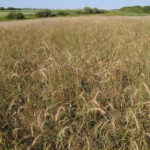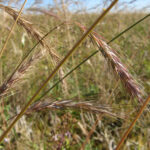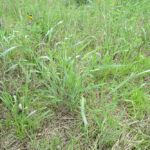Canada Wildrye
Elymus canadensis
General Description
Canada wildrye is a short-lived, tall, tufted, cool season, perennial bunchgrass. It is also known as nodding wildrye in some areas. It is often found growing naturally in riparian areas. Canada wildrye’s erect and leafy hollow stems grow to 60 to 150 cm (24 to 59 in.) in height. Leaf blades are flat and wide, waxy green, and sometimes curled. Its seed heads have thick bristles that tend to ‘nod’ over as if they are a bit top heavy.
Type
Native grass.
Origin
Native to North America.
Longevity
Less than 5 years.
Use
Reclamation, pasture, hay.
Optimal Time of Use
Spring, summer. Canada wildrye grows rapidly in spring, and if grazed should be used after it has reached a height of 13 cm (5 in) in spring or early summer before it matures.
Recovery After Use
Canada wildrye grows slowly after grazing or haying and should be rested for an entire growing season following use.
Palatability/Nutritional Value
Canada wildrye is considered to be good forage early in the season, but is less desirable as it matures. Forage quality is poor when mature; although the energy value is relatively good, the protein value is very poor. Canada wildrye has fair to good palatability for wildlife.
Annual Precipitation min/max (mm)
500mm / 1140mm
Drought Tolerance
Canada wildrye has moderate drought tolerance, but is best adapted to moist areas.
Flooding Tolerance
Withstands 1-2 weeks of flooding.
Winter Hardiness
Good winter hardiness.
Soil Texture Preference
Canada wildrye can grow on any soil texture, but prefers coarse-textured soils. It is often found growing native in riparian areas, in wooded areas, on sandy shores and along trails and other disturbed areas.
Erosion Control
Canada wildrye provides excellent erosion control. It establishes quickly and has good seedling vigour providing quick stabilization on disturbed sites.
Salinity Tolerance
No tolerance.
Acidity Tolerance
Moderate tolerance. Canada wildrye tolerates soil pH levels as low as 5.0.
Alkalinity Tolerance
Unknown.
Seeds per kg
250,000 seeds/kg (113,000 seeds/lb)
Suggested Mixtures
Often included in native seeding mixtures as a rapidly establishing plant for cover that is replaced by longer-living species. It is particularly well suited for use in riparian areas. It is known for its rapid cover and site stabilization in mixtures for roadside, parks and recreational areas, prairie restoration, and critical areas.
Ease of Establishment
Canada wildrye is easily established. Seedlings are exceptionally vigorous.
Competitiveness
Canada wildrye is not considered to be very competitive or invasive.
Management Considerations
Persistence of Canada wildrye is increased if plants are allowed to set seed and establish seedlings.
Saskatchewan Dryland Forage Species Adaptation Tool, USDA Plants Database, British Columbia Rangeland Seeding Manual
Canada wildrye is not common in the the region. It is adapted to coarse textured soils and dry to moist river bars and gravelly meadows.
Canada wildrye is not common in the the region. It is adapted to coarse textured soils and dry to moist river bars and gravelly meadows.
Canada wildrye is found in native plant communities in the Peace-Liard region, near river banks and sandy areas. Some references report Canada wildrye has poor salinity tolerance, while others indicate good salinity tolerance.


